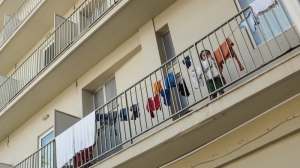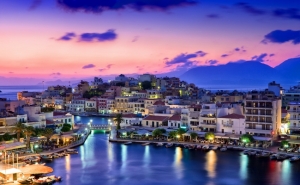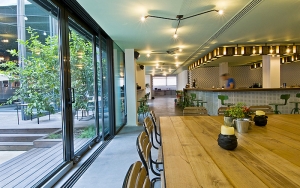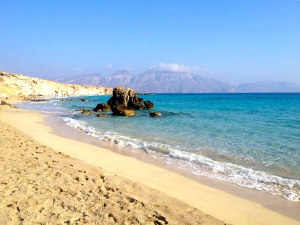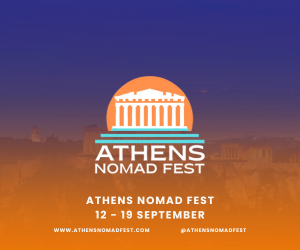LIFE & CULTURE
XpatAthens
Thursday, 29 September 2016 00:18
XpatAthens Among Recommended Blogs For Expats In Greece
We are thrilled that XpatAthens has made the 2016 Expat Focus list of recommended blogs for expats in Greece! Expat Focus’ mission is to find resources on the web that will help prospective expats adjust to a new country.
We love sharing information about our city and will continue to do our very best to enhance the expat experience in Athens! Stay connected with us through our weekly newsletter, on Facebook and on Twitter.
We love sharing information about our city and will continue to do our very best to enhance the expat experience in Athens! Stay connected with us through our weekly newsletter, on Facebook and on Twitter.
Published in
Local News
Tagged under
Thursday, 22 September 2016 19:29
Spyros Gianniotis & The Elite Athletes Of Open Water Swimming In Santorini Experience 2016
Complete your registration in Santorini Experience and receive 50% discount on your ferry tickets with Blue Star Ferries!
Santorini Experience alongside Maria Sampanidou. Santorini Experience 2016 is just two weeks away from its implementation and the interest of people is now peaked for the greatest sporting weekend, giving their appointment in the island of Santorini, on October 7-9, 2016!
With the support of the Municipality of Santorini, the Municipal Sports Cultural Environmental Organization of Santorini (D.A.P.P.O.S.) and for the first time with the kind support of the Greek National Tourism Organization, Santorini Experience is already counting a record in participations, from Greece and abroad, while a record is also achieved in the occupancy of the hotel accommodations from the hospitality sponsors that support the event throughout the second weekend of October!
Spyros Gianniotis and top open water swimmers from the Greek national open water swimming team will participate in Santorini Experience 2016!
The Silver Olympic medalist & World Champion in open water swimming will be in Santorini for a second consecutive year and together with him, the top names of the Greek national open water swimming team. Among them, the World Champions in open water swimming, Kelly Araouzou and Antonis Fokaidis, the European Champion, Giorgos Arniakos and the Champion Dimitris Negris. Swimming clubs and athletes from all over Greece will be in Santorini with the support of the Hellenic Swimming Federation (the event is held under the Auspices of the Federation) and the presence of its President, Mr. Dimitris Diathesopoulos.
The access to the volcanic island of the Cyclades is now even easier with the support of Blue Star Ferries which offers 50% discount on your ferry tickets during the days of the event! The procedure is easy! Further to the completion of your registration at Santorini Experience 2016, interested parties should contact for their reservations the GELASAKIS STC agency in Piraeus at the following number 210 422 2440.
The 50% discount on your tickets and your vehicles is ONLY valid if you have completed your registration, so that the organizers will be able to inform the agency accordingly. Each person who has completed his/her registration is entitled to the same discount for 3 more people (if these are his/her escorts) or for 4 people (if these are family members). Those who are interested in buying ferry tickets should receive their tickets at least two days before their departure. Important note: discount depends on availability (based on the occupancy and the available tickets) and is valid for travels that will be implemented during the days of the event.
Further more, the flights added by the official airline partner, Ryanair, offers and benefits from the sponsors of the event are still running and can be found in the following link: http://santorini-experience.com/event_offers.html
Running and swimming are highlighted for one more year in “Santorini Experience”. On Saturday October 8th 2016, professional and amateur runners will be able to run and live the adrenaline of Caldera! The starting time for both 10 km and 15 km routes is at 08:15 am in the morning, while the starting time of the 5km route will take place at 11:00. All routes start from the desalination plant in Oia.
Moreover, on Sunday October 9th, 2016, professional and amateur swimmers will be able to sense the eruptive atmosphere of the volcano with the impressive view of the island in front of them! The starting time of the unique swimming route of 1.5 mile (2.4 km) of Santorini Experience, will take place at 10:00 am, from the volcano to the old port in Fira.
Registrations in swimming and running will continue until September 30th through the official page of the event in the following link: http://activemedia.com.gr/product/santorini-experience-2/ or alternatively at Alafouzos Sport store at Fira (in Santorini), the official sponsor of the event supporting it for a second consecutive year. From Thursday, October 6 to Saturday, October 8, 2016, all participants will be able to receive their numbers from Alafouzos Sport store (hours: 09:00-21:00).
Alternatively the running participants may also receive their numbers one hour before the start of their route on Saturday October 8, 2016, from the desalination plant in Oia while the swimming participants may also receive their numbers one hour before their start from the old port in Fira.
Santorini Experience alongside ‘Iron Samba’!
Maria Sampanidou or ‘Iron Samba’, as she is called by her friends in the world of sports, gives the most crucial fight after a severe stroke she suffered and needs the help by all of us!
The athlete, suffered from her young age by the autoimmune syndrome called Hughes, which causes blood clots; and a change in her drug treatment caused a clot in the blood and as a result she paralyzed on one side and is in partial aphasia. Maria participated last year in “Santorini Experience” and had signed up to participate for this year too. The organization feels obliged to stand next to her in this difficult time of her life. Part of the “Santorini Experience” revenues will be given to the Give&Fund created to support Maria’s rehabilitation race. Anyone can support Maria Sampanidou through the following page: http://www.giveandfund.com/giveandfund/project/Ironsamba
The occupancy of the hotels is already in high standards that is why you will have to move quickly and get advantage of the special prices offered in one of the hospitality sponsors of the event. The most recent entries in the hospitality sponsors of the event are Vedema A Luxury Collection Resort Santorini, Sunday Suites Santorini and Maistros Village Hotel while for more information you may also address your request to Aqua Vista Hotels, Santorini Hoteliers Association, Meltemi Hotels & Resorts, Athina Luxury Suites, Santorini Secret Suites & Spa, Caldera Collection, West East Suites, 270 Oia's View, White Pearl Villas, Central Fira Hotel, Memories Hotel, Loizos Stylish Residencies, Esperas and Sienna Residencies which are available in the following link: http://santorini-experience.com/event_accommodation_en.html. The page will be daily enriched with new supporters.
Santorini Experience will be held under the auspices of the Greek National Tourism Organization and the Hellenic Swimming Federation and will receive the international promotion of FOX Sports TV network of FOX Networks Group, participating in this year's event as the Official Broadcaster.
Santorini Experience is a collaboration between the Municipality of Santorini, the Municipal Sports Cultural Environmental Organization of Santorini (D.A.P.P.O.S.) and Active Media Group.
Promo Video
Official Sponsors: Alafouzos Sport, Blue Star Ferries, With the Kind Support of the Greek National Tourism Organization, Santorini Boatmen Union
Official Airline Partner: Ryanair
Official Supporters: Ford Motor Hellas, “Vikos” Natural Mineral Water, Avance Rent A Car, Aqua Vista Hotels, Saucony, Arena, Village Cinemas, Santorini Yachting Club, Passagio Santorini
Official Broadcaster: FOX Sports
Hospitality Sponsors: Santorini Hoteliers Association, Meltemi Hotels & Resorts, Athina Luxury Suites, Santorini Secret Suites & Spa, Vedema A Luxury Collection Resort Santorini, Sunday Suites Santorini, Caldera Collection, West East Suites, 270 Oia's View, White Pearl Villas, Central Fira Hotel, Memories Hotel, Loizos Stylish Residencies, Esperas, Maistros Village Hotel, Sienna Residencies
Assisted by: Diana “exoplizein”
With the Kind Support & Under the Auspices of the Greek National Tourism Organization
Website
Facebook Page
Facebook Event
Twitter
Youtube Channel
Instagram
Google+
Image Credit: Elias Lefas
Official Sponsors: Alafouzos Sport, Blue Star Ferries, With the Kind Support of the Greek National Tourism Organization, Santorini Boatmen Union
Official Airline Partner: Ryanair
Official Supporters: Ford Motor Hellas, “Vikos” Natural Mineral Water, Avance Rent A Car, Aqua Vista Hotels, Saucony, Arena, Village Cinemas, Santorini Yachting Club, Passagio Santorini
Official Broadcaster: FOX Sports
Hospitality Sponsors: Santorini Hoteliers Association, Meltemi Hotels & Resorts, Athina Luxury Suites, Santorini Secret Suites & Spa, Vedema A Luxury Collection Resort Santorini, Sunday Suites Santorini, Caldera Collection, West East Suites, 270 Oia's View, White Pearl Villas, Central Fira Hotel, Memories Hotel, Loizos Stylish Residencies, Esperas, Maistros Village Hotel, Sienna Residencies
Assisted by: Diana “exoplizein”
With the Kind Support & Under the Auspices of the Greek National Tourism Organization
Website
Facebook Page
Facebook Event
Youtube Channel
Google+
Image Credit: Elias Lefas
Published in
Local News
Tagged under
Monday, 23 July 2018 07:00
Greek Fig Jam
Good news; figs are finally in season! Make this easy fig jam recipe, which will go great with nuts, blue cheese, and prosciutto.
Ingredients
- 1 kg ripped figs, peeled and chopped
- 500gr caster sugar
- Lemon juice of one lemon
- 1 glass of water
To read the directions, please visit: Greece By A Greek
Published in
Greek Food & Diet
Tagged under
Tuesday, 27 September 2016 07:00
Greece Guest Of Honour At Moscow's International Book Fair
Greece was the recent guest of honour at Moscow’s recent 29th International Book Fair, which took place early September 2016 at Moscow’s largest exhibition center.
The Russian Federal Agency for Press and Mass Communication appointed Greece as the Guest of Honour on the occasion of the Joint Year Greece-Russia 2016, while Russia was in turn the Guest of Honour at the 13th International Thessaloniki Book Fair in May 2016.
Visitors had the chance to become acquainted with aspects of Greek culture as there were around 600 publications from 50 publishing houses, all representing the scientific and artistic side of Greece spanning from antiquity, the Byzantine era, the Enlightenment, 20th century, and modern day.
Prominent Greek writers and artists went to Moscow to participate in the programme of events, which included 30 events aimed at introducing the modern cultural face of a small country with a great history that maintains deep historical and cultural ties with Russia through literature, cinema, visual arts, and music.
The programme at Moscow’s International Book Fair was developed by the Hellenic Foundation for Culture with the collaboration and support of Cavafy Archive-Onassis Foundation, the State Museum of Contemporary Art, the Greek Film Archive, the Greek Film Center, Michael Cacoyannis Foundation, ASIFA HELLAS, Greekanimation.com, Greek IBBY, the Embassy of Greece to the Russian Federation, as well as with the Department of Byzantine and Modern Greek Studies of the Lomonosov Moscow State University.
To read this article in full, please visit: Greek News Agenda
To read this article in full, please visit: Greek News Agenda
Published in
Greece In The News
Tagged under
Monday, 26 September 2016 07:00
Refugees Turn Abandoned Hotel In Athens Into Peaceful Home
Activists and refugees have turned this abandoned hotel in the heart of Athens into a new community. The City Plaza hotel is now home to nearly 400 refugees stuck in Greece after the rest of Europe closed its borders to them. Their goal is to build a peaceful and supportive community.
For more information, please visit: Al Jazeera
Published in
Videos
Tagged under
Thursday, 22 September 2016 21:17
Qatar Airways Starts Flying A380 To Sydney Due To Increase In Passenger Demand
Sydney has become Qatar Airways’ first destination in Australia to be served by the super-jumbo A380 aircraft, just six months after it joined the carrier’s global network.
Following the route’s inauguration with the Boeing 777-300 on 1 March 2016, Qatar Airways has seen a steady growth in demand for its service on the route. The 517-seater A380 aircraft increases Qatar Airways’ current daily capacity by 44 percent on this route to meet the growing travel and trade demand.
Qatar Airways Group Chief Executive, Mr. Akbar Al Baker, said, “From the moment we inaugurated service to Sydney earlier this year, we have been welcomed with open arms. Customers flying to and from Sydney appreciate our global route network and our efficient flight schedules, which save them hours of time on the average itinerary. We are pleased to respond in kind with the introduction of the A380 service to Sydney, offering 517 seats per flight.”
Mr. Akbar Al Baker also said, “Qatar Airways brings travellers from Australia to more destinations in Europe, the Middle East and Africa than any other airline serving Australia today. Australia is one of the main hubs of the business world in Asia Pacific, with many passengers flying worldwide for business and leisure. What better way to serve travellers from this key destination than to introduce our iconic A380 to the country, starting with the nation’s biggest hub, Sydney.”
The 517-seat capacity is spread across twin decks in a tri-class configuration of eight seats in First Class, 48 seats in Business Class, and 461 in Economy Class, featuring world-class amenities and first rate services that set it apart from other aircraft. Passengers travelling from Sydney to London and Paris can enjoy the Qatar Airways A380 experience throughout their journey to these two European destinations.
“We’re thrilled that Qatar Airways has upgraded to an A380 within six months of the airline’s launch in Sydney, which is testament to their early success and strong loads,” Sydney Airport Managing Director and Chief Executive Officer Kerrie Mather said.
“Qatar Airways’ Doha to Sydney service already generates an estimated 3,000 jobs and contributes more than $240 million to the economy per year, plus it provides passengers with more choice and connectivity. Sydney Airport estimates that Qatar Airways’ A380 will deliver an incremental $78 million in inbound visitor expenditure annually to Australia, supporting the federal government’s target of doubling overnight visitor expenditure by 2020. On behalf of Sydney Airport, I’d like to congratulate Qatar Airways on this significant milestone and wish them continued success on the route.”
The A380 aircraft will feature a luxurious and exclusive First Class Cabin with ultra-wide seats, which automatically recline into a flat bed, two-passenger table extension dining, sleeper suits, flight slippers, and amenities from Giorgio Armani. Passengers travelling with Qatar Airways’ award-winning Business Class can also enjoy private aisle access with the 1-2-1 seat configuration and a suite of connectivity options including on-board Wi-Fi, keeping them fully connected while up in the air.
In addition, passengers in First and Business Class can relax and socialise in the on-board lounge located on the upper deck of the super-jumbo.
Economy Class passengers will also benefit with the added spaciousness of the A380, with higher ceilings on the main deck, a wider seat configuration and design to offer more leg room plus contoured headrests.
When transiting through Qatar Airways’ hub, Hamad International Airport in Doha, passengers travelling from Sydney can enjoy a comfortable and efficient transit. The luxurious and modern airport has more than 40,000 square metres of retail space and restaurants including more than 70 retail and 30 food and beverage outlets, as well as a 25-metre swimming pool, gym, hotel, and spa.
Daily Flight Schedule
Depart Doha QR908 at 21:40, arrive in Sydney at 19:35 (next day)
Depart Sydney QR909 at 22:25, arrive in Doha at 05:05 (next day)
About Qatar Airways
Qatar Airways, the national carrier of the State of Qatar, is one of the fastest growing airlines operating one of the youngest fleets in the world. Now in its 19th year of operations, Qatar Airways has a modern fleet of 190 aircraft flying to more than 150 key business and leisure destinations across six continents.
A multiple award-winning airline, Qatar Airways was awarded World's Best Business Class, Best Business Class Airline Lounge, and Best Airline Staff Service in the Middle East at the prestigious 2016 World Airline Awards managed by international air transport rating organisation Skytrax.
Qatar Airways is a member of the oneworld global alliance. The award-winning alliance was named the World’s Best Airline Alliance 2015 by Skytrax for the third year running. Qatar Airways was the first Gulf carrier to join global airline alliance, oneworld, enabling its passengers to benefit from more than 1,000 airports in more than 150 countries, with 14,250 daily departures.
About Qatar Airways
Qatar Airways, the national carrier of the State of Qatar, is one of the fastest growing airlines operating one of the youngest fleets in the world. Now in its 19th year of operations, Qatar Airways has a modern fleet of 190 aircraft flying to more than 150 key business and leisure destinations across six continents.
A multiple award-winning airline, Qatar Airways was awarded World's Best Business Class, Best Business Class Airline Lounge, and Best Airline Staff Service in the Middle East at the prestigious 2016 World Airline Awards managed by international air transport rating organisation Skytrax.
Qatar Airways is a member of the oneworld global alliance. The award-winning alliance was named the World’s Best Airline Alliance 2015 by Skytrax for the third year running. Qatar Airways was the first Gulf carrier to join global airline alliance, oneworld, enabling its passengers to benefit from more than 1,000 airports in more than 150 countries, with 14,250 daily departures.
For more information, please visit their website: Qatar Airways
Published in
International Travel
Tagged under
Thursday, 22 September 2016 07:00
Major Luxury Tourism Projects Across Greece Help Boost Economy
Foreign investors are placing their bets on Greek tourism with more than 3,200 new rooms in the works.
Experts say new accommodation units, most in the luxury category, as well as the accompanying services, will further boost the tourism sector and help the Greek economy.
Among the projects underway are Miriam Hellas in the Lassithi prefecture of Crete, which will be handled by a Russian-interests consortium. The project is budgeted at 408 million euros and involves the development of 850 acres of land near the popular Elounda area which will include 380 tourist homes, three five-star hotels as well as a marina, shops, wellness centers, restaurants and bars, athletic centers, and recreational parks.
Another is the Arabic-interests RSR Eagle Resort in Karystos, Evia, which will include some 400 tourism residences, hotels, a marina, and a conference center with a budget of 200 million euros.
To read this article in full, please visit: Greek Travel Pages
To read this article in full, please visit: Greek Travel Pages
Published in
Greece In The News
Tagged under
Thursday, 22 September 2016 07:00
48 Urban Garden - Dinner At The Gallery
A food truck in a restaurant? A cocktail bar with its own herb garden? A gallery that is all about fun? All this and more is the word at 48 Urban Garden, which filled in a small vacuum in the Athenian restaurant scene with its fresh, original and unaffected concept.
48 Urban Garden shares a roof with the Ileana Tounta Contemporary Art Center, with the two operating in conjunction with each other. The Airstream food truck located in the restaurant’s dining hall is not just a pretty piece of the décor, it serves as the kitchen. The dining area’s big windows look out onto an urban garden that enlivens the grey apartment blocks surrounding it. It is built on different levels and has picnic tables as well as herb patches and a lemon tree.
The food is inspired by street staples with a more creative and “restauranty” approach. Try the tuna tataki, spicy burritos, the beautifully roasted picanha beef and the rib-eye steak, a mix-and-match of the elements that define Asian and ethnic cuisines. Over at the bar, the cocktails are designed to complement the food, light and refreshing. The music is the cherry on the icing, bringing together the whole ambiance.
Telephone: 213 028 1866
Article Source: Greece Is
Published in
Restaurants In Athens
Tagged under
Tuesday, 20 September 2016 07:00
Unchartered & Uninhabited Island Destinations In Greece
Greece is made up of a half a dozen archipelagos making it easy to see how there are a plethora of amazing uninhabited islands around Greece that visitors can add to their list of places to visit on their next Grecian holiday!
Keros Island
Located northwest of Amorgos, Keros island is a part of the Koufonissia islands and boasts important archaeological sites and excavations. Archaeologist have uncovered ruins from the Early Cycladic period 3200-2000 BC and in ancient times, it was called Keria. The beaches have white sand and the water is turquoise. People may visit the island on their own boat or by hiring an excursion boat. Overnight stays are not permitted by the Archaeological Authority that watches over the island.
Lihadonisia
Lihadonisia is an island complex located across from Kamena Vourla in Evia. The islands are dotted with beaches that were created by volcanic inlets. Often referred to as the “Maldives” of Greece, the islands emerged as a result of a massive earthquake thousands of years ago and volcanic activity during the Cenozoic century. Thought to have been named after the servant of the God Hercules, Lihas, the islands can be reached via boat excursions operating from the harbor of Kavos in Evia.
Gramvousa
Gramvousa
Gramvousa is part of the Cretan islands archipelago. The two islands it refers to are Imeri and Agria Gramvousa, literally “tame” and “wild” Gramvousa. You can take a one day boat trip leaving in the morning and returning at night from Kissamos port and arriving at Gramvousa and Balos beach & lagoon. Day tours are available from May to October. Known for spectacular beaches, flora and fauna, and the remains of the Venetian castle and fort that tops Imeri Gramvousa peaks, these two islands are not to be missed.
To read this article in full, please visit: Greek Reporter
Published in
Travel Greece
Tagged under
Tuesday, 20 September 2016 07:00
3 Greek Islands Among List Of Places With Best Food In The World
Islands have always been associated in people’s minds with beautiful sandy beaches, palm trees, sun beds & summer cocktails. However, apart from all of that, the best islands in the world also offer delicious food!
An annual survey conducted by Travel + Leisure gave readers the opportunity to rank their favorite islands not only for their beaches, but also for the quality of restaurants and the food they provide.
The list consisted of 20 islands worldwide and among them were 3 Greek ones famous for their cuisine and fine dining.
Santorini gained 5th position in the list, followed by Mykonos and Crete!
The Travel + Leisure List for Islands with the Best Food
An annual survey conducted by Travel + Leisure gave readers the opportunity to rank their favorite islands not only for their beaches, but also for the quality of restaurants and the food they provide.
The list consisted of 20 islands worldwide and among them were 3 Greek ones famous for their cuisine and fine dining.
Santorini gained 5th position in the list, followed by Mykonos and Crete!
The Travel + Leisure List for Islands with the Best Food
- Nantucket
- St. Bart's
- Maui, Hawaii
- Sicily
- Santorini
- Maldives
- Harbour Island
- Capri
- Hilton Head
- Oahu, Hawaii
- Bali
- Mykonos
- Malta
- Mallorca
- Vancouver Island
- Florida Keys
- Golden Isles
- Crete
- Kauai, Hawaii
- Anguilla
Originally posted on ellines.com
Translated by XpatAthens
Published in
Greece In The News
Tagged under






